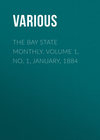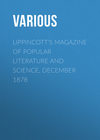Czytaj książkę: «Notes and Queries, Number 51, October 19, 1850»
NOTES
ROBERD THE ROBBER
In the Vision of Piers Ploughman are two remarkable passages in which mention is made of "Roberd the robber," and of "Roberdes knaves."
"Roberd the robbere,
On Reddite loked,
And for ther was noght wherof
He wepte swithe soore."
Wright's ed., vol. i. p. 105.
"In glotonye, God woot,
Go thei to bedde,
And risen with ribaudie,
The Roberdes knaves."
Vol. i. p. 3.
In a note on the second passage, Mr. Wright quotes a statute of Edw. III., in which certain malefactors are classed together "qui sont appellez Roberdesmen, Wastours, et Dragelatche:" and on the first he quotes two curious instances in which the name is applied in a similar manner,—one from a Latin song of the reign of Henry III.:
"Competenter per Robert, robbur designatur;
Robertus excoriat, extorquet, et minatur.
Vir quicunque rabidus consors est Roberto."
It seems not impossible that we have in these passages a trace of some forgotten mythical personage. "Whitaker," says Mr. Wright, "supposes, without any reason, the 'Roberde's knaves' to be 'Robin Hood's men.'" (Vol. ii. p. 506.) It is singular enough, however, that as early as the time of Henry III. we find the term 'consors Roberto' applied generally, as designating any common thief or robber; and without asserting that there is any direct allusion to "Robin Hood's men" in the expression "Roberdes knaves," one is tempted to ask whence the hero of Sherwood got his own name?
Grimm (Deutsche Mythol., p. 472.) has suggested that Robin Hood may be connected with an equally famous namesake, Robin Goodfellow; and that he may have been so called from the hood or hoodikin, which is a well-known characteristic of the mischievous elves. I believe, however, it is now generally admitted that "Robin Hood" is a corruption of "Robin o' th' Wood" equivalent to "silvaticus" or "wildman"—a term which, as we learn from Ordericus, was generally given to those Saxons who fled to the woods and morasses, and long held them against their Norman enemies.
It is not impossible that "Robin o' the Wood" may have been a general name for any such outlaws as these and that Robin Hood, as well as "Roberd the Robbere" may stand for some earlier and forgotten hero of Saxon tradition. It may be remarked that "Robin" is the Norman diminutive of "Robert", and that the latter is the name by which we should have expected to find the doings of a Saxon hero commemorated. It is true that Norman and Saxon soon came to have their feelings and traditions in common; but it is not the less curious to find the old Saxon name still traditionally applied by the people, as it seems to have been from the Vision of Piers Ploughman.
Whether Robin Goodfellow and his German brother "Knecht Ruprecht" are at all connected with Robin Hood, seems very doubtful. The plants which, both in England and in Germany, are thus named, appear to belong to the elf rather than to the outlaw. The wild geranium, called "Herb Robert" in Gerarde's time, is known in Germany as "Ruprecht's Kraut". "Poor Robin", "Ragged Robin", and "Robin in the Hose", probably all commemorate the same "merry wanderer of the night."
RICHARD JOHN KING.
ON A PASSAGE IN "THE MERRY WIVES OF WINDSOR," AND ON CONJECTURAL EMENDATION
The late Mr. Baron Field, in his Conjectures on some Obscure and Corrupt Passages of Shakspeare, published in the "Shakspeare Society's Papers," vol. ii. p. 47., has the following, note on The Merry Wives of Windsor, Act ii. Sc. 2.:—
"'Falstaff. I myself sometimes having the fear of heaven on the left hand, and hiding mine honour in my necessity, am fain to shuffle, to hedge, and to lurch; and yet you, you rogue, will esconce your rags, your cat-a-mountain looks, your red-lattice phrases and your bold-beating oaths, under the shelter of your honour.'
"Pistol, to whom this was addressed, was an ensign, and therefore rags can hardly bear the ordinary interpretation. A rag is a beggarly fellow, but that will make little better sense here. Associated as the phrase is, I think it must mean rages, and I find the word used for ragings in the compound bard-rags, border-ragings or incursions, in Spenser's Fairy Queen, ii. x. 63., and Colin Clout, v. 315."
Having on one occasion found that a petty larceny committed on the received text of the poet, by taking away a superfluous b, made all clear, perhaps I may be allowed to restore the abstracted letter, which had only been misplaced and read brags, with, I trust, the like success? Be it remembered that Pistol, a braggadocio, is made up of brags and slang; and for that reason I would also read, with Hanmer, bull-baiting, instead of the unmeaning "bold-beating oaths."
I well know with what extreme caution conjectural emendation is to be exercised; but I cannot consent to carry it to the excess, or to preserve a vicious reading, merely because it is warranted by the old copies.
Regretting, as I do, that Mr. Collier's, as well as Mr. Knight's, edition of the poet, should both be disfigured by this excess of caution, I venture to subjoin a cento from George Withers, which has been inscribed in the blank leaf of one of them.
"Though they will not for a better
Change a syllable or letter,
Must the Printer's spots and stains
Still obscure THE POET'S Strains?
Overspread with antique rust,
Like whitewash on his painted bust
Which to remove revived the grace
And true expression of his face.
So, when I find misplaced B's,
I will do as I shall please.
If my method they deride,
Let them know I am not tied,
In my free'r course, to chuse
Such strait rules as they would use;
Though I something miss of might,
To express his meaning quite.
For I neither fear nor care
What in this their censures are;
If the art here used be
Their dislike, it liketh me.
While I linger on each strain,
And read, and read it o'er again,
I am loth to part from thence,
Until I trace the poet's sense,
And have the Printer's errors found,
In which the folios abound."
PERIERGUS BIBLIOPHILUS.
October.
Minor Notes
Chaucer's Damascene.—Warton, in his account of the physicians who formed the Library of the Doctor of Physic, says of John Damascene that he was "Secretary to one of the caliphs, wrote in various sciences before the Arabians had entered Europe, and had seen the Grecian philosophers." (History of English Poetry, Price's ed., ii. 204.) Mr. Saunders, in his book entitled Cabinet Pictures of English Life, "Chaucer", after repeating the very words of this meagre account, adds, "He was, however, more famous for his religious than his medical writings; and obtained for his eloquence the name of the Golden-flowing" (p 183.) Now Mr. Saunders certainly, whatever Warton did, has confounded Damascenus, the physician, with Johannes Damascenus Chrysorrhoas, "the last of the Greek Fathers," (Gibbon, iv. 472.) a voluminous writer on ecclesiastical subjects, but no physician, and therefore not at all likely to be found among the books of Chaucer's Doctour,
"Whose studie was but litel on the Bible."
Chaucer's Damascene is the author of Aphorismorum Liber, and of Medicinæ Therapeuticæ, libri vii. Some suppose him to have lived in the ninth, others in the eleventh century, A.D.; and this is about all that is known about him. (See Biographie Universelle, s.v.)
ED. S. JACKSON.
Long Friday, meaning of.—C. Knight, in his Pictorial Shakspeare, explains Mrs. Quickly's phrase in Henry the Fourth—"'Tis a long loan for a poor lone woman to bear,"—by the synonym great: asserting that long is still used in the sense of great, in the north of England; and quoting the Scotch proverb, "Between you and the long day be it," where we talk of the great day of judgment. May not this be the meaning of the name Long Friday, which was almost invariably used by our Saxon forefathers for what we now call Good Friday? The commentators on the Prayer Book, who all confess themselves ignorant of the real meaning of the term, absurdly suggest that it was so called from the great length of the services on that day; or else, from the length of the fast which preceded. Surely, The Great Friday, the Friday on which the great work of our redemption was completed, makes better sense?
T.E.L.L.
Hip, hip, Hurrah!—Originally a war cry, adopted by the stormers of a German town, wherein a great many Jews had taken their refuge. The place being sacked, they were all put to the sword, under the shouts of, Hierosolyma est perdita! From the first letter of those words (H.e.p.) an exclamation was contrived. We little think, when the red wine sparkles in the cup, and soul-stirring toasts are applauded by our Hip, hip, hurrah! that we record the fall of Jerusalem, and the cruelty of Christians against the chosen people of God.
JANUS DOUSA.
Under the Rose (Vol. i., p. 214.).—Near Zandpoort, a village in the vicinity of Haarlem, Prince William of Orange, the third of his name, had a favourite hunting-seat, called after him the Princenbosch, now more generally known under the designation of the Kruidberg. In the neighbourhood of these grounds there was a little summer-house, making part, if I recollect rightly, of an Amsterdam burgomaster's country place, who resided there at the times I speak of. In this pavilion, it is said, and beneath a stucco rose, being one of the ornaments of the ceiling, William III. communicated the scheme of his intended invasion in England to the two burgomasters of Amsterdam there present. You know the result.
Can the expression of "being under the rose" date from this occasion, or was it merely owing to coincidence that such an ornament protected, as it were, the mysterious conversation to which England owes her liberty, and Protestant Christendom the maintenance of its rights?
JANUS DOUSA.
Huis te Manpadt.
Albanian Literature.—Bogdano, Pietro, Archivescovo di Scopia, L'Infallibile Verita della Cattolica Fede, in Venetia, per G. Albrizzi, MDXCI, is I think much older than any Albanian book mentioned by Hobhouse. The same additional characters are used which occur in the later publications of the Propaganda, in two parts, pp. 182. 162.
F.Q.
Queries
BIBLIOGRAPHICAL QUERIES
1. Has anything recently transpired which could lead bibliographers to form an absolute decision with regard to the "unknown" printer who used the singular letter R which is said to have originated with Finiguerra in 1452? That Mentelin was the individual seems scarcely credible; and there is a manifest difference between his type and that of the anonymous printer of the editio princeps of Rabanus Maurus, De Universo, the copy of which work (illuminated, ruled, and rubricated) now before me was once in Heber's possession; and it exhibits the peculiar letter R, which resembles an ill-formed A, destitute of the cross stroke, and supporting a round O on its reclined back. (Panzer, i. 78.; Santander, i. 240.)
2. Is it not quite certain that the acts and decrees of the synod of Würtzburg, held in the year 1452, were printed in that city previously to the publication of the Breviarium Herbiplense in 1479? The letter Q which is used in the volume of these acts is remarkable for being of a double semilunar shape; and the type, which is very Gothic, is evidently the same as that employed in an edition of other synodal decrees in Germany about the year 1470.
3. When and where was the Liber de Laudibus gloriosissime Dei genitricis Marie semper Virginis, by Albertus Magnus, first printed? I do not mean the supposititious work, which is often confounded with the other one; but that which is also styled Super Evangelium Missus est Quæstiones. And why are these Questions invariably said to be 230 in number, when there are 275 chapters in the book? Beughem asserts that the earliest edition is that of Milan in 1489 (Vid. Quetif et Echard, i. 176.), but what I believe to be a volume of older date is "sine ullâ notâ;" and a bookseller's observation respecting it is, that it is "very rare, and unknown to De Bure, Panzer, Brunet, and Dibdin."
4. Has any discovery made as to the author of the extraordinary 4to. tract, Oracio querulosa contra Inuasores Sacerdotum? According to the Crevenna Catalogue (i. 85.), the work is "inconnu à tous les bibliographes." Compare Seemiller, ii. 162.; but the copy before me is not of the impression described by him. It is worthy of notice, that at signature A iiiij the writer declares, "nostris jam temporibus calchographiam, hoc est impressioram artem, in nobilissima Vrbanie germe Maguncia fuisse repertam."
5. Are we to suppose that either carelessness or a love of conjectures was the source of Chevillier's mistake, not corrected by Greswell (Annals of Paris. Typog., p. 6.), that signatures were first introduced, anno 1476, by Zarotus, the printer, at Milan? They may doubtless be seen in the Opus Alexandride Ales super tertium Sententiarum, Venet. 1475, a book which supplies also the most ancient instance I have met with of a "Registrum Chartarum." Signatures, however, had a prior existence; for they appear in the Mammetractus printed at Beron Minster in 1470 (Meermau, ii. 28.; Kloss, p. 192.), but they were omitted in the impression of 1476. Dr. Cotton (Typ. Gaz., p. 66.), Mr. Horne (Introd. to Bibliog., i. 187. 317), and many others, wrongly delay the invention or adoption of them till the year 1472.
6. Is the edition of the Fasciculus Temporum, set forth at Cologne by Nicolaus de Schlettstadt in 1474, altogether distinct from that which is confessedly "omnium prima," and which was issued by Arnoldus Ther Huernen in the same year? If it be, the copy in the Lambeth library, bearing date 1476, and entered in pp. 1, 2. of Dr. Maitland's very valuable and accurate List, must appertain to the third, not the second, impression. To the latter this Louvain reprint of 1476 is assigned in the catalogue of the books of Dr. Kloss (p. 127.), but there is an error in the remark that the "Tabula" prefixed to the editio princeps is comprised in eight leaves, for it certainly consists of nine.
7. Where was what is probably a copy of the second edition of the Catena Aurea of Aquinas printed? The folio in question, which consists of 417 unnumbered leaves, is an extremely fine one, and I should say that it is certainly of German origin. Seemiller (i. 117.) refers it to Esslingen, and perhaps an acquaintance with its water-marks would afford some assistance in tracing it. Of these a rose is the most common, and a strigilis may be seen on folio 61. It would be difficult to persuade the proprietor of this volume that it is of so modern a date as 1474, the year in which what is generally called the second impression of this work appeared.
8. How can we best account for the mistake relative to the imaginary Bologna edition of Ptolemy's Cosmography in 1462, a copy of which was in the Colbert library? (Leuglet du Fresnoy, Méth. pour étud. l'Hist., iii. 8., à Paris, 1735.) That it was published previously to the famous Mentz Bible of this date is altogether impossible; and was the figure 6 a misprint for 8? or should we attempt to subvert it into 9? The editio princeps of the Latin version by Angelus is in Roman letter, and is a very handsome specimen of Vicenza typography in 1475, when it was set forth "ab Hermano Leuilapide," alias Hermann Lichtenstein.
9. If it be true, as Dr. Cotton remarks in his excellent Typographical Gazetteer, p. 22., that a press was erected at Augsburg, in the monastery of SS. Ulric and Afra, in the year 1472, and that Anthony Sorg is believed to have been the printer, why should we be induced to assent to the validity of Panzer's supposition that Nider's Formicarius did not make its appearance there until 1480? It would seem to be more than doubtful that Cologne can boast of having produced the first edition, A.D. 1475/7; and it may be reasonably asserted, and an examination of the book will abundantly strengthen the idea, that the earliest impression is that which contains this colophon, in which I would dwell upon the word "editionem" (well known to the initiated): "Explicit quintus ac totus formicarii liber uxta editionem fratris Iohannis Nider," &c., "Impressum Auguste per Anthonium Sorg."
10. In what place and year was Wilhelmi Summa Viciorum first printed? Fabricius and Cave are certainly mistaken when they say Colon. 1479. In the volume, which I maintain to be of greater antiquity, the letters c and t, s and t, are curiously united, and the commencement of it is: "Incipit summa viciorum seu tractatus moral' edita [sic] a fratre vilhelmo episcopo lugdunĕs. ordinsq. fratrû predicator." The description given by Quetif and Echard (i. 132.) of the primary impression of Perault's book only makes a bibliomaniac more anxious for information about it: "in Inc. typ. absque loco anno et nomine typographi, sine numeris reclamat. et majusculis."
11. Was Panormitan's Lectura super primo Decretalium indubitably issued at Venice, prior to the 1st of April, 1473? and if so, does it contain in the colophon these lines by Zovenzonius, which I transcribe from a noble copy bearing this date?
"Abbatis pars prima notis que fulget aliemis
Est vindelini pressa labore mei:
Cuius ego ingenium de vertice palladis ortum
Crediderim. veniam tu mihi spira dabis."
12. Is it not unquestionable that Heroldt's Promptuarium Exemplorum was published at least as early as his Sermones? The type in both works is clearly identical, and the imprint in the latter, at the end of Serm. cxxxvi., vol. ii., is Colon. 1474, an edition unknown to very nearly all bibliographers. For instance, Panzer and Denis commence with that of Rostock, in 1476; Laire with that of Cologne, 1478; and Maittaire with that of Nuremberg, in 1480. Different statements have been made as to the precise period when this humble-minded writer lived. Altamura (Bibl. Domin., pp. 147. 500.) places him in the year 1400. Quetif and Echard (i. 762.), Fabricius and Mansi (Bibl. Med. et inf. Latin.), prefer 1418, on the unstable ground of a testimony supposed to have proceeded from the author himself; for whatever confusion or depravation may have been introduced into subsequent impressions, the editio princeps, of which I have spoken, does not present to our view the alleged passage, viz., "à Christo autem transacti sunt millequadringenti decem et octo anni," but most plainly, "M.cccc. & liij. anni." (Serm. lxxxv., tom. ii.) To this same "Discipulus" Oudin (iii. 2654.), and Gerius in the Appendix to Cave (p. 187.), attribute the Speculorum Exemplorum, respecting which I have before proposed a Query; but I am convinced that they have confounded the Speculum with the Promptuarium. The former was first printed at Deventer, A.D. 1481, and the compiler of it enters upon his prologue in the following striking style: "Impressoria arte jamdudum longe lateque per orbem diffusa, multiplicatisque libris quarumcunque fere materiarum," &c. He then expresses his surprise at the want of a good collection of Exempla; and why should we determine without evidence that he must have been Heroldus?
R.G.
FAIRFAX'S TASSO
In a copy of Fairfax's Godfrey of Bulloigne, ed. 1600 (the first), which I possess, there occurs a very curious variorum reading of the first stanza of the first book. The stanza, as it is given by Mr. Knight in his excellent modern editions, reads thus:
"The sacred armies and the godly knight,
That the great sepulchre of Christ did free,
I sing; much wrought his valour and foresight,
And in that glorious war much suffer'd he;
In vain 'gainst him did hell oppose her might,
In vain the Turks and Morians armed be;
His soldiers wild, to brawls and mutines prest,
Reduced he to peace, so heaven him blest."
By holding up the leaf of my copy to the light, it is easy to see that the stanza stood originally as given above, but a cancel slip printed in precisely the same type as the rest of the book gives the following elegant variation:
"I sing the warre made in the Holy Land,
And the Great Chiefe that Christ's great tombe did free:
Much wrought he with his wit, much with his hand,
Much in that braue atchieument suffred hee:
In vaine doth hell that Man of God withstand,
In vaine the worlds great princes armed bee;
For heau'n him fauour'd; and he brought againe
Vnder one standard all his scatt'red traine."
Queries.—1. Does the above variation occur in any or many other copies of the edition of 1600?
2. Which reading is followed in the second old edition?
T.N.
Demerary, September 11. 1850.




















